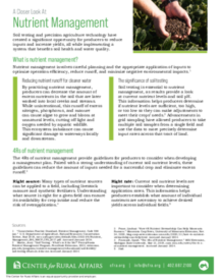Soil testing and precision agriculture technology have created a significant opportunity for producers to reduce inputs and increase yields, all while implementing a system that benefits soil health and water quality.
What is nutrient management?
Nutrient management involves careful planning and the appropriate application of inputs to optimize operation efficiency, reduce runoff, and minimize negative environmental impacts.
Reducing nutrient runoff for cleaner water
By practicing nutrient management, producers can decrease the amount of excess nutrients in the soil that are later washed into local creeks and streams. While unintentional, this runoff of excess nitrogen, phosphorus, and manure can cause algae to grow and bloom at unnatural levels, cutting off light and oxygen needed by aquatic wildlife. This ecosystem imbalance can cause significant damage to waterways locally and downstream.
The significance of soil testing
Soil testing is essential to nutrient management, as results provide a look at current nutrient levels and soil pH. This information helps producers determine if nutrient levels are sufficient, too high, or too low so they can make adjustments to meet their crops’ needs. Advancements in grid sampling have allowed producers to take multiple soil samples from a single field and use the data to more precisely determine input rates across that tract of land.


